IT Service Management at Celanese: A Case Study Analysis and Report
VerifiedAdded on 2022/11/13
|7
|2322
|103
Case Study
AI Summary
This report presents a case study on IT service management at Celanese, a global leader in the chemical industry. It analyzes the company's IT infrastructure, processes, and the integration of ITIL best practices. The report covers financial management, demand management, strategy management, and service portfolio management within Celanese. It also discusses the successful integration of these processes, the influence of ITIL, and the use of the RACI model in the OSM. Furthermore, the report highlights difficulties in the OSM and the implementation of the Zendesk tool for improved customer relationships. The conclusion emphasizes the benefits of effective service management for Celanese, including improved IT service delivery and customer satisfaction. The case study provides a comprehensive overview of Celanese's IT service management journey, offering insights into its challenges and successes.
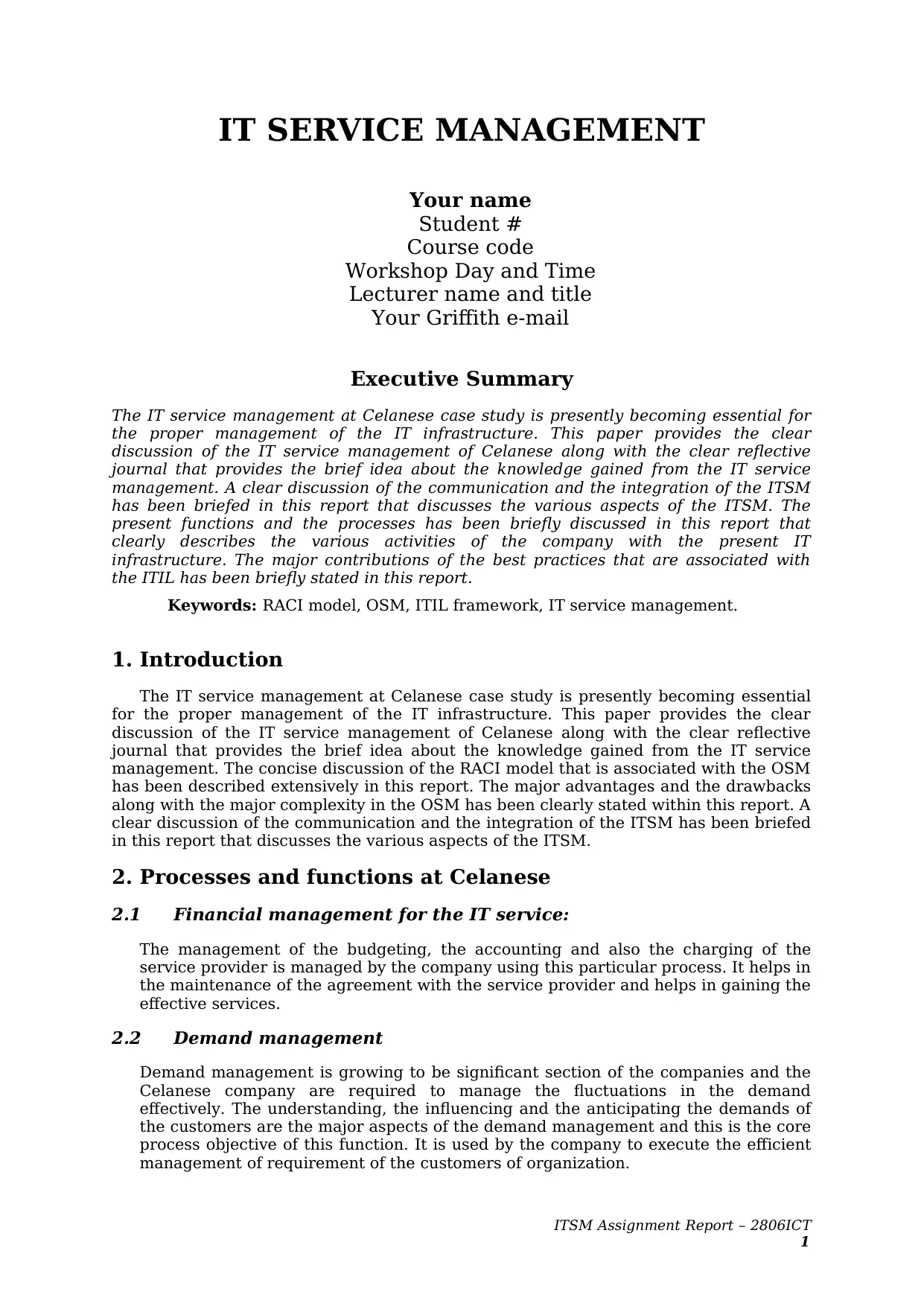
IT SERVICE MANAGEMENT
Your name
Student #
Course code
Workshop Day and Time
Lecturer name and title
Your Griffith e-mail
Executive Summary
The IT service management at Celanese case study is presently becoming essential for
the proper management of the IT infrastructure. This paper provides the clear
discussion of the IT service management of Celanese along with the clear reflective
journal that provides the brief idea about the knowledge gained from the IT service
management. A clear discussion of the communication and the integration of the ITSM
has been briefed in this report that discusses the various aspects of the ITSM. The
present functions and the processes has been briefly discussed in this report that
clearly describes the various activities of the company with the present IT
infrastructure. The major contributions of the best practices that are associated with
the ITIL has been briefly stated in this report.
Keywords: RACI model, OSM, ITIL framework, IT service management.
1. Introduction
The IT service management at Celanese case study is presently becoming essential
for the proper management of the IT infrastructure. This paper provides the clear
discussion of the IT service management of Celanese along with the clear reflective
journal that provides the brief idea about the knowledge gained from the IT service
management. The concise discussion of the RACI model that is associated with the OSM
has been described extensively in this report. The major advantages and the drawbacks
along with the major complexity in the OSM has been clearly stated within this report. A
clear discussion of the communication and the integration of the ITSM has been briefed
in this report that discusses the various aspects of the ITSM.
2. Processes and functions at Celanese
2.1 Financial management for the IT service:
The management of the budgeting, the accounting and also the charging of the
service provider is managed by the company using this particular process. It helps in
the maintenance of the agreement with the service provider and helps in gaining the
effective services.
2.2 Demand management
Demand management is growing to be significant section of the companies and the
Celanese company are required to manage the fluctuations in the demand
effectively. The understanding, the influencing and the anticipating the demands of
the customers are the major aspects of the demand management and this is the core
process objective of this function. It is used by the company to execute the efficient
management of requirement of the customers of organization.
ITSM Assignment Report – 2806ICT
1
Your name
Student #
Course code
Workshop Day and Time
Lecturer name and title
Your Griffith e-mail
Executive Summary
The IT service management at Celanese case study is presently becoming essential for
the proper management of the IT infrastructure. This paper provides the clear
discussion of the IT service management of Celanese along with the clear reflective
journal that provides the brief idea about the knowledge gained from the IT service
management. A clear discussion of the communication and the integration of the ITSM
has been briefed in this report that discusses the various aspects of the ITSM. The
present functions and the processes has been briefly discussed in this report that
clearly describes the various activities of the company with the present IT
infrastructure. The major contributions of the best practices that are associated with
the ITIL has been briefly stated in this report.
Keywords: RACI model, OSM, ITIL framework, IT service management.
1. Introduction
The IT service management at Celanese case study is presently becoming essential
for the proper management of the IT infrastructure. This paper provides the clear
discussion of the IT service management of Celanese along with the clear reflective
journal that provides the brief idea about the knowledge gained from the IT service
management. The concise discussion of the RACI model that is associated with the OSM
has been described extensively in this report. The major advantages and the drawbacks
along with the major complexity in the OSM has been clearly stated within this report. A
clear discussion of the communication and the integration of the ITSM has been briefed
in this report that discusses the various aspects of the ITSM.
2. Processes and functions at Celanese
2.1 Financial management for the IT service:
The management of the budgeting, the accounting and also the charging of the
service provider is managed by the company using this particular process. It helps in
the maintenance of the agreement with the service provider and helps in gaining the
effective services.
2.2 Demand management
Demand management is growing to be significant section of the companies and the
Celanese company are required to manage the fluctuations in the demand
effectively. The understanding, the influencing and the anticipating the demands of
the customers are the major aspects of the demand management and this is the core
process objective of this function. It is used by the company to execute the efficient
management of requirement of the customers of organization.
ITSM Assignment Report – 2806ICT
1
Paraphrase This Document
Need a fresh take? Get an instant paraphrase of this document with our AI Paraphraser
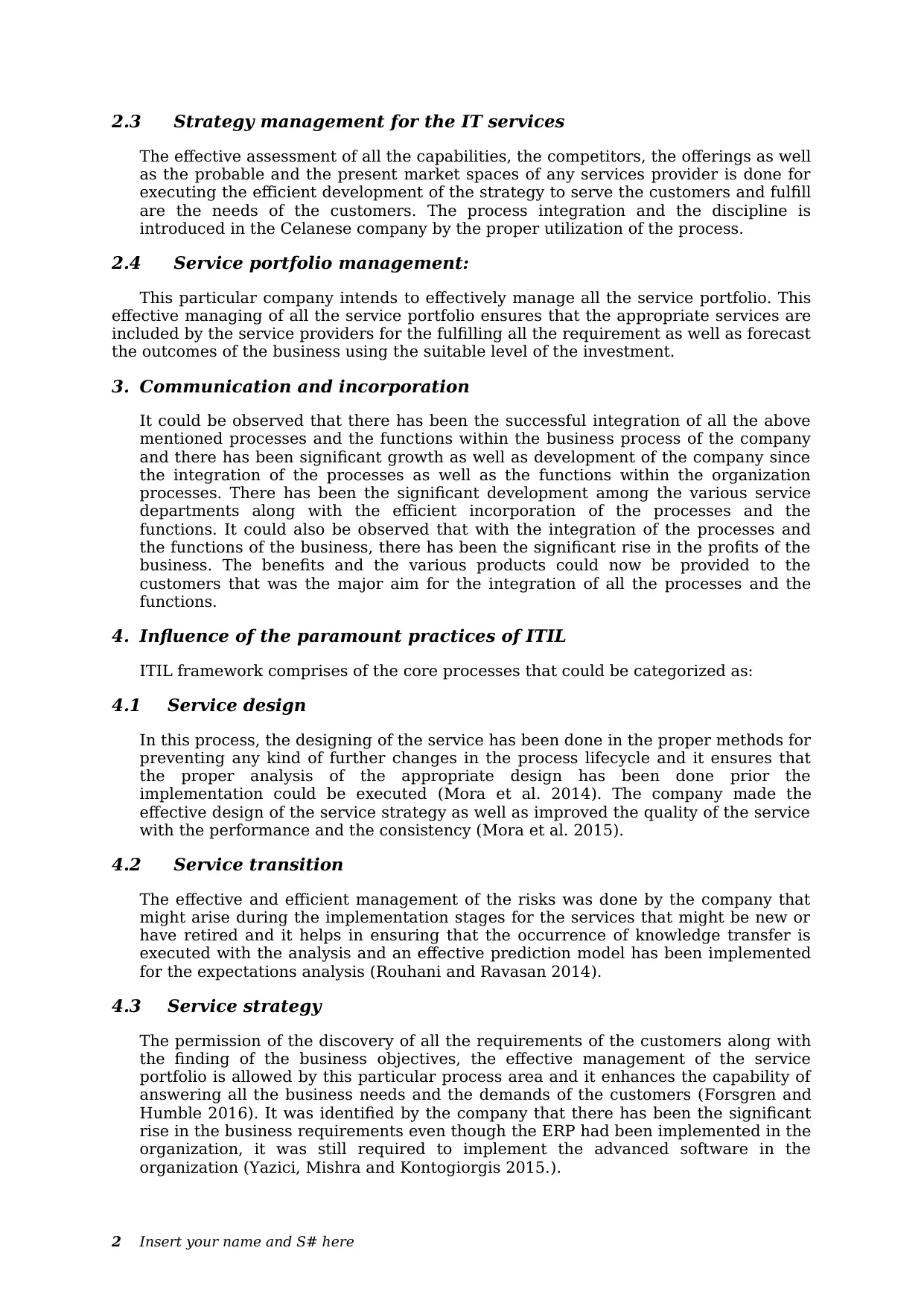
2.3 Strategy management for the IT services
The effective assessment of all the capabilities, the competitors, the offerings as well
as the probable and the present market spaces of any services provider is done for
executing the efficient development of the strategy to serve the customers and fulfill
are the needs of the customers. The process integration and the discipline is
introduced in the Celanese company by the proper utilization of the process.
2.4 Service portfolio management:
This particular company intends to effectively manage all the service portfolio. This
effective managing of all the service portfolio ensures that the appropriate services are
included by the service providers for the fulfilling all the requirement as well as forecast
the outcomes of the business using the suitable level of the investment.
3. Communication and incorporation
It could be observed that there has been the successful integration of all the above
mentioned processes and the functions within the business process of the company
and there has been significant growth as well as development of the company since
the integration of the processes as well as the functions within the organization
processes. There has been the significant development among the various service
departments along with the efficient incorporation of the processes and the
functions. It could also be observed that with the integration of the processes and
the functions of the business, there has been the significant rise in the profits of the
business. The benefits and the various products could now be provided to the
customers that was the major aim for the integration of all the processes and the
functions.
4. Influence of the paramount practices of ITIL
ITIL framework comprises of the core processes that could be categorized as:
4.1 Service design
In this process, the designing of the service has been done in the proper methods for
preventing any kind of further changes in the process lifecycle and it ensures that
the proper analysis of the appropriate design has been done prior the
implementation could be executed (Mora et al. 2014). The company made the
effective design of the service strategy as well as improved the quality of the service
with the performance and the consistency (Mora et al. 2015).
4.2 Service transition
The effective and efficient management of the risks was done by the company that
might arise during the implementation stages for the services that might be new or
have retired and it helps in ensuring that the occurrence of knowledge transfer is
executed with the analysis and an effective prediction model has been implemented
for the expectations analysis (Rouhani and Ravasan 2014).
4.3 Service strategy
The permission of the discovery of all the requirements of the customers along with
the finding of the business objectives, the effective management of the service
portfolio is allowed by this particular process area and it enhances the capability of
answering all the business needs and the demands of the customers (Forsgren and
Humble 2016). It was identified by the company that there has been the significant
rise in the business requirements even though the ERP had been implemented in the
organization, it was still required to implement the advanced software in the
organization (Yazici, Mishra and Kontogiorgis 2015.).
2 Insert your name and S# here
The effective assessment of all the capabilities, the competitors, the offerings as well
as the probable and the present market spaces of any services provider is done for
executing the efficient development of the strategy to serve the customers and fulfill
are the needs of the customers. The process integration and the discipline is
introduced in the Celanese company by the proper utilization of the process.
2.4 Service portfolio management:
This particular company intends to effectively manage all the service portfolio. This
effective managing of all the service portfolio ensures that the appropriate services are
included by the service providers for the fulfilling all the requirement as well as forecast
the outcomes of the business using the suitable level of the investment.
3. Communication and incorporation
It could be observed that there has been the successful integration of all the above
mentioned processes and the functions within the business process of the company
and there has been significant growth as well as development of the company since
the integration of the processes as well as the functions within the organization
processes. There has been the significant development among the various service
departments along with the efficient incorporation of the processes and the
functions. It could also be observed that with the integration of the processes and
the functions of the business, there has been the significant rise in the profits of the
business. The benefits and the various products could now be provided to the
customers that was the major aim for the integration of all the processes and the
functions.
4. Influence of the paramount practices of ITIL
ITIL framework comprises of the core processes that could be categorized as:
4.1 Service design
In this process, the designing of the service has been done in the proper methods for
preventing any kind of further changes in the process lifecycle and it ensures that
the proper analysis of the appropriate design has been done prior the
implementation could be executed (Mora et al. 2014). The company made the
effective design of the service strategy as well as improved the quality of the service
with the performance and the consistency (Mora et al. 2015).
4.2 Service transition
The effective and efficient management of the risks was done by the company that
might arise during the implementation stages for the services that might be new or
have retired and it helps in ensuring that the occurrence of knowledge transfer is
executed with the analysis and an effective prediction model has been implemented
for the expectations analysis (Rouhani and Ravasan 2014).
4.3 Service strategy
The permission of the discovery of all the requirements of the customers along with
the finding of the business objectives, the effective management of the service
portfolio is allowed by this particular process area and it enhances the capability of
answering all the business needs and the demands of the customers (Forsgren and
Humble 2016). It was identified by the company that there has been the significant
rise in the business requirements even though the ERP had been implemented in the
organization, it was still required to implement the advanced software in the
organization (Yazici, Mishra and Kontogiorgis 2015.).
2 Insert your name and S# here
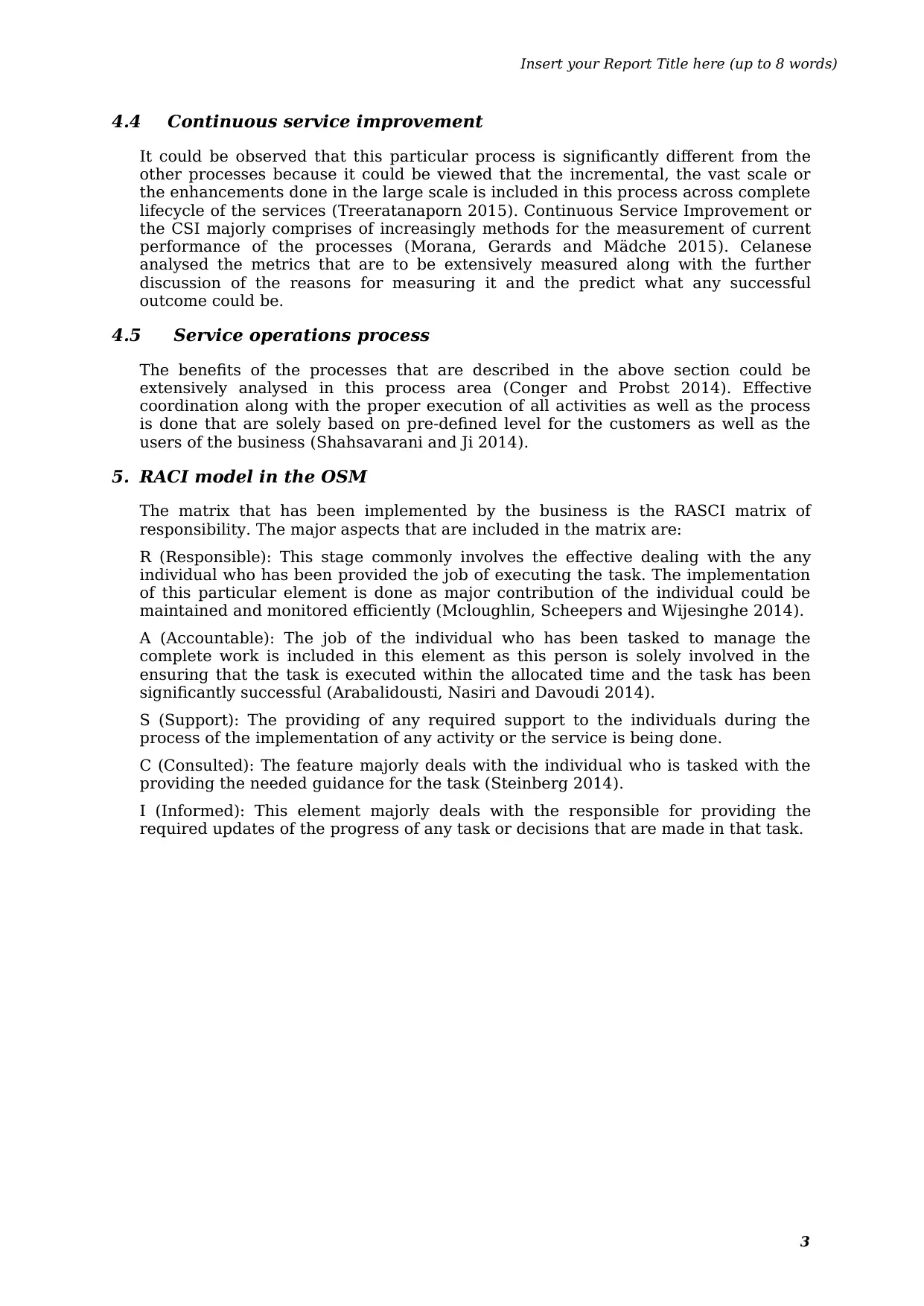
Insert your Report Title here (up to 8 words)
4.4 Continuous service improvement
It could be observed that this particular process is significantly different from the
other processes because it could be viewed that the incremental, the vast scale or
the enhancements done in the large scale is included in this process across complete
lifecycle of the services (Treeratanaporn 2015). Continuous Service Improvement or
the CSI majorly comprises of increasingly methods for the measurement of current
performance of the processes (Morana, Gerards and Mädche 2015). Celanese
analysed the metrics that are to be extensively measured along with the further
discussion of the reasons for measuring it and the predict what any successful
outcome could be.
4.5 Service operations process
The benefits of the processes that are described in the above section could be
extensively analysed in this process area (Conger and Probst 2014). Effective
coordination along with the proper execution of all activities as well as the process
is done that are solely based on pre-defined level for the customers as well as the
users of the business (Shahsavarani and Ji 2014).
5. RACI model in the OSM
The matrix that has been implemented by the business is the RASCI matrix of
responsibility. The major aspects that are included in the matrix are:
R (Responsible): This stage commonly involves the effective dealing with the any
individual who has been provided the job of executing the task. The implementation
of this particular element is done as major contribution of the individual could be
maintained and monitored efficiently (Mcloughlin, Scheepers and Wijesinghe 2014).
A (Accountable): The job of the individual who has been tasked to manage the
complete work is included in this element as this person is solely involved in the
ensuring that the task is executed within the allocated time and the task has been
significantly successful (Arabalidousti, Nasiri and Davoudi 2014).
S (Support): The providing of any required support to the individuals during the
process of the implementation of any activity or the service is being done.
C (Consulted): The feature majorly deals with the individual who is tasked with the
providing the needed guidance for the task (Steinberg 2014).
I (Informed): This element majorly deals with the responsible for providing the
required updates of the progress of any task or decisions that are made in that task.
3
4.4 Continuous service improvement
It could be observed that this particular process is significantly different from the
other processes because it could be viewed that the incremental, the vast scale or
the enhancements done in the large scale is included in this process across complete
lifecycle of the services (Treeratanaporn 2015). Continuous Service Improvement or
the CSI majorly comprises of increasingly methods for the measurement of current
performance of the processes (Morana, Gerards and Mädche 2015). Celanese
analysed the metrics that are to be extensively measured along with the further
discussion of the reasons for measuring it and the predict what any successful
outcome could be.
4.5 Service operations process
The benefits of the processes that are described in the above section could be
extensively analysed in this process area (Conger and Probst 2014). Effective
coordination along with the proper execution of all activities as well as the process
is done that are solely based on pre-defined level for the customers as well as the
users of the business (Shahsavarani and Ji 2014).
5. RACI model in the OSM
The matrix that has been implemented by the business is the RASCI matrix of
responsibility. The major aspects that are included in the matrix are:
R (Responsible): This stage commonly involves the effective dealing with the any
individual who has been provided the job of executing the task. The implementation
of this particular element is done as major contribution of the individual could be
maintained and monitored efficiently (Mcloughlin, Scheepers and Wijesinghe 2014).
A (Accountable): The job of the individual who has been tasked to manage the
complete work is included in this element as this person is solely involved in the
ensuring that the task is executed within the allocated time and the task has been
significantly successful (Arabalidousti, Nasiri and Davoudi 2014).
S (Support): The providing of any required support to the individuals during the
process of the implementation of any activity or the service is being done.
C (Consulted): The feature majorly deals with the individual who is tasked with the
providing the needed guidance for the task (Steinberg 2014).
I (Informed): This element majorly deals with the responsible for providing the
required updates of the progress of any task or decisions that are made in that task.
3
⊘ This is a preview!⊘
Do you want full access?
Subscribe today to unlock all pages.

Trusted by 1+ million students worldwide
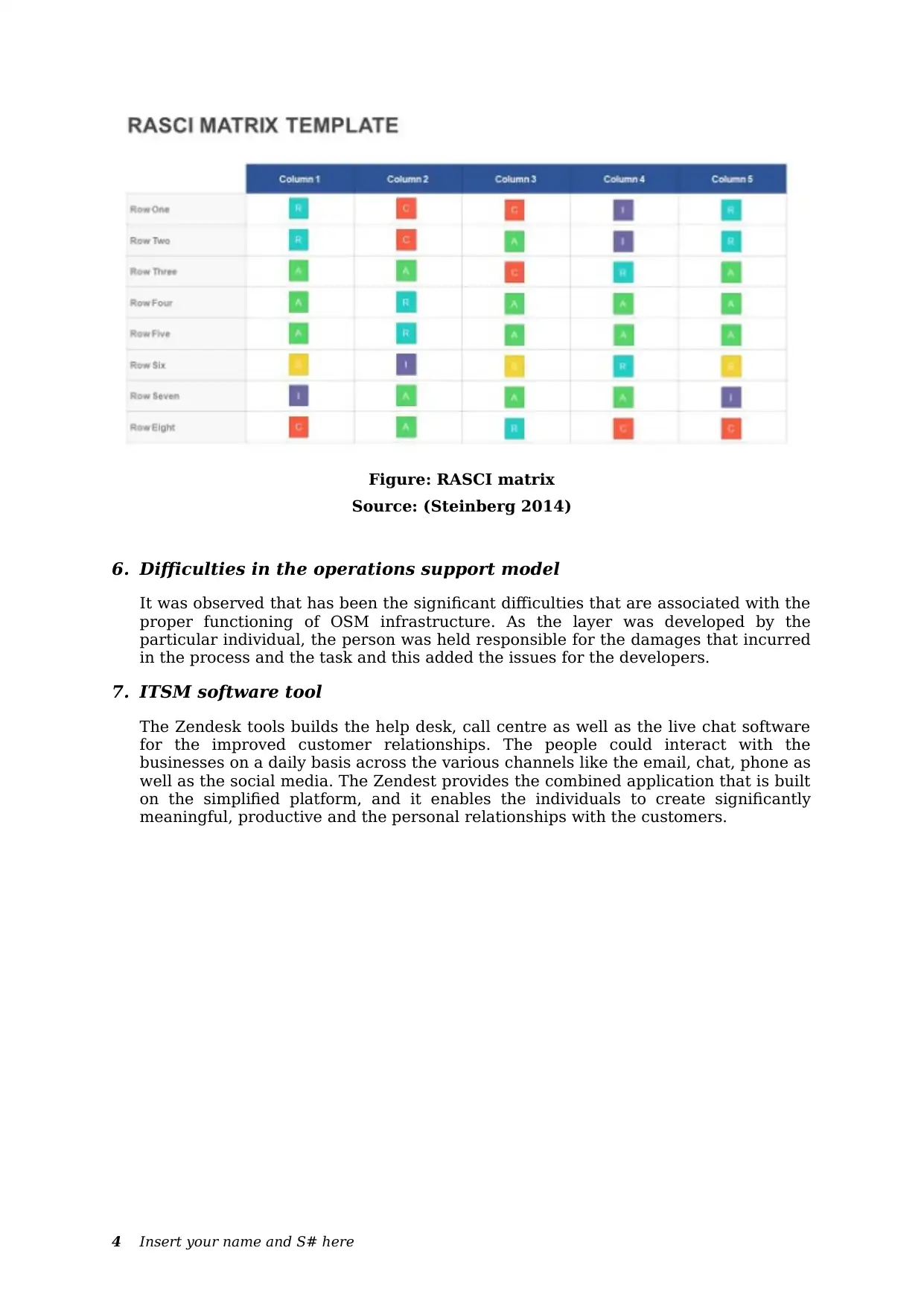
Figure: RASCI matrix
Source: (Steinberg 2014)
6. Difficulties in the operations support model
It was observed that has been the significant difficulties that are associated with the
proper functioning of OSM infrastructure. As the layer was developed by the
particular individual, the person was held responsible for the damages that incurred
in the process and the task and this added the issues for the developers.
7. ITSM software tool
The Zendesk tools builds the help desk, call centre as well as the live chat software
for the improved customer relationships. The people could interact with the
businesses on a daily basis across the various channels like the email, chat, phone as
well as the social media. The Zendest provides the combined application that is built
on the simplified platform, and it enables the individuals to create significantly
meaningful, productive and the personal relationships with the customers.
4 Insert your name and S# here
Source: (Steinberg 2014)
6. Difficulties in the operations support model
It was observed that has been the significant difficulties that are associated with the
proper functioning of OSM infrastructure. As the layer was developed by the
particular individual, the person was held responsible for the damages that incurred
in the process and the task and this added the issues for the developers.
7. ITSM software tool
The Zendesk tools builds the help desk, call centre as well as the live chat software
for the improved customer relationships. The people could interact with the
businesses on a daily basis across the various channels like the email, chat, phone as
well as the social media. The Zendest provides the combined application that is built
on the simplified platform, and it enables the individuals to create significantly
meaningful, productive and the personal relationships with the customers.
4 Insert your name and S# here
Paraphrase This Document
Need a fresh take? Get an instant paraphrase of this document with our AI Paraphraser
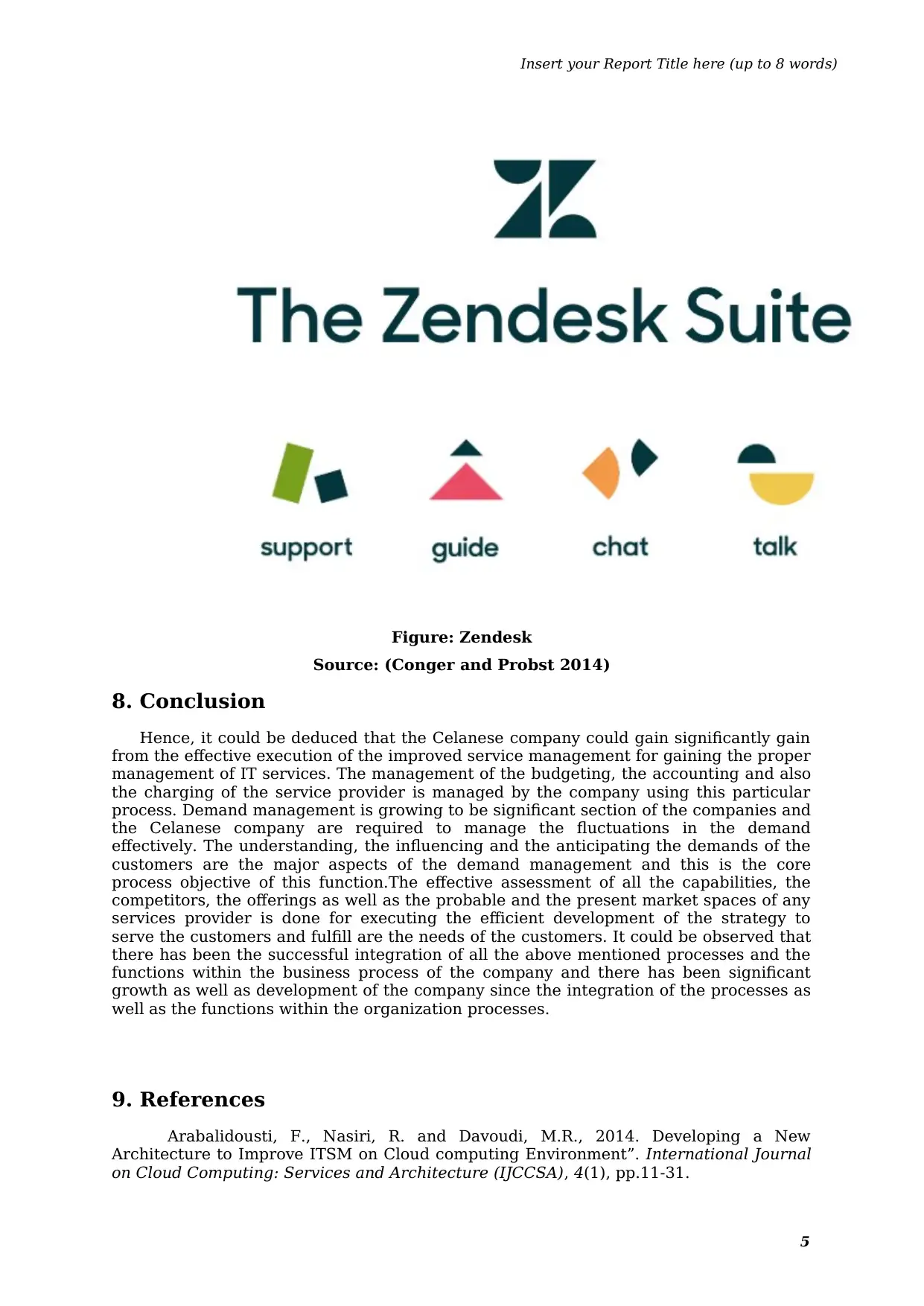
Insert your Report Title here (up to 8 words)
Figure: Zendesk
Source: (Conger and Probst 2014)
8. Conclusion
Hence, it could be deduced that the Celanese company could gain significantly gain
from the effective execution of the improved service management for gaining the proper
management of IT services. The management of the budgeting, the accounting and also
the charging of the service provider is managed by the company using this particular
process. Demand management is growing to be significant section of the companies and
the Celanese company are required to manage the fluctuations in the demand
effectively. The understanding, the influencing and the anticipating the demands of the
customers are the major aspects of the demand management and this is the core
process objective of this function.The effective assessment of all the capabilities, the
competitors, the offerings as well as the probable and the present market spaces of any
services provider is done for executing the efficient development of the strategy to
serve the customers and fulfill are the needs of the customers. It could be observed that
there has been the successful integration of all the above mentioned processes and the
functions within the business process of the company and there has been significant
growth as well as development of the company since the integration of the processes as
well as the functions within the organization processes.
9. References
Arabalidousti, F., Nasiri, R. and Davoudi, M.R., 2014. Developing a New
Architecture to Improve ITSM on Cloud computing Environment”. International Journal
on Cloud Computing: Services and Architecture (IJCCSA), 4(1), pp.11-31.
5
Figure: Zendesk
Source: (Conger and Probst 2014)
8. Conclusion
Hence, it could be deduced that the Celanese company could gain significantly gain
from the effective execution of the improved service management for gaining the proper
management of IT services. The management of the budgeting, the accounting and also
the charging of the service provider is managed by the company using this particular
process. Demand management is growing to be significant section of the companies and
the Celanese company are required to manage the fluctuations in the demand
effectively. The understanding, the influencing and the anticipating the demands of the
customers are the major aspects of the demand management and this is the core
process objective of this function.The effective assessment of all the capabilities, the
competitors, the offerings as well as the probable and the present market spaces of any
services provider is done for executing the efficient development of the strategy to
serve the customers and fulfill are the needs of the customers. It could be observed that
there has been the successful integration of all the above mentioned processes and the
functions within the business process of the company and there has been significant
growth as well as development of the company since the integration of the processes as
well as the functions within the organization processes.
9. References
Arabalidousti, F., Nasiri, R. and Davoudi, M.R., 2014. Developing a New
Architecture to Improve ITSM on Cloud computing Environment”. International Journal
on Cloud Computing: Services and Architecture (IJCCSA), 4(1), pp.11-31.
5
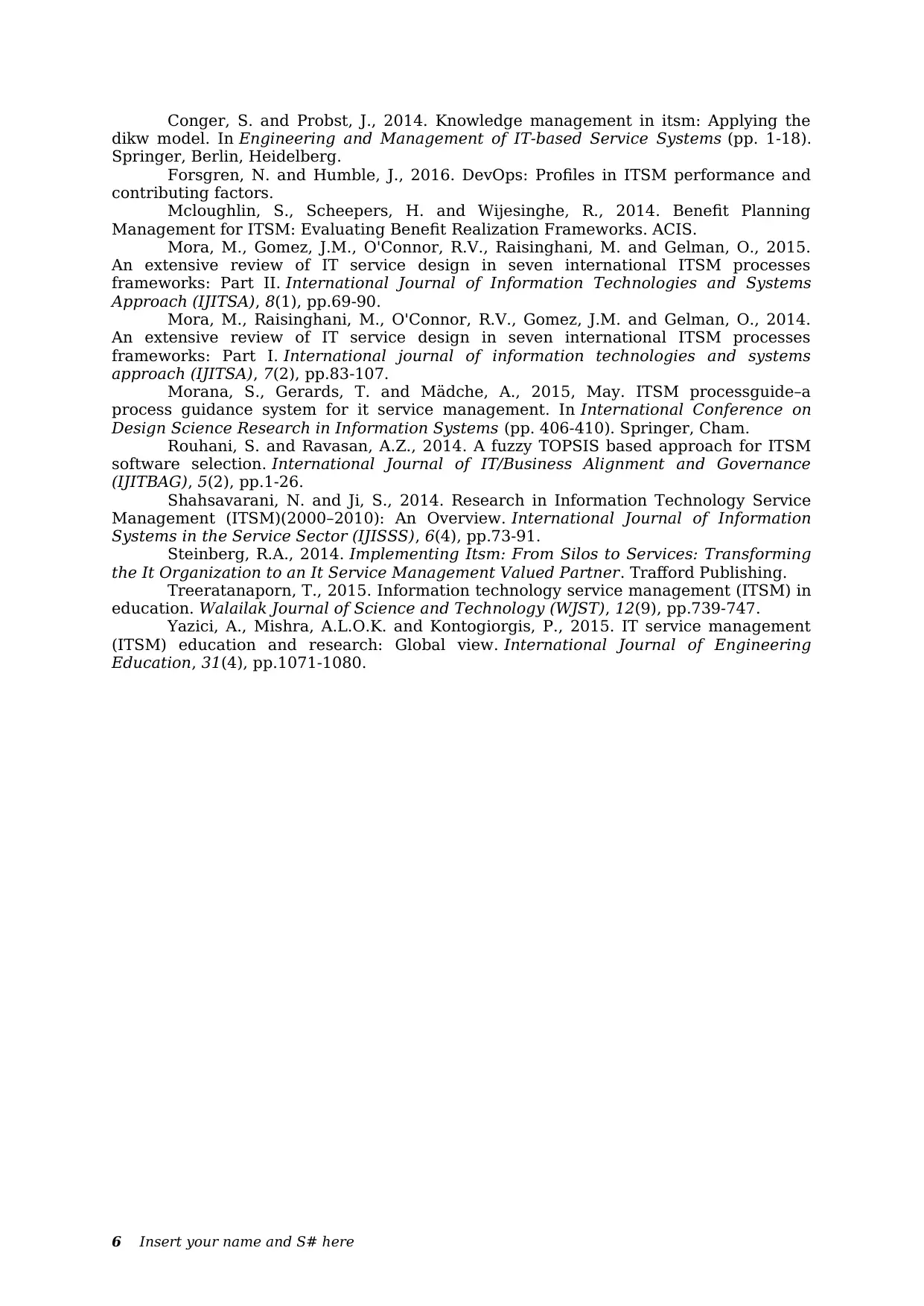
Conger, S. and Probst, J., 2014. Knowledge management in itsm: Applying the
dikw model. In Engineering and Management of IT-based Service Systems (pp. 1-18).
Springer, Berlin, Heidelberg.
Forsgren, N. and Humble, J., 2016. DevOps: Profiles in ITSM performance and
contributing factors.
Mcloughlin, S., Scheepers, H. and Wijesinghe, R., 2014. Benefit Planning
Management for ITSM: Evaluating Benefit Realization Frameworks. ACIS.
Mora, M., Gomez, J.M., O'Connor, R.V., Raisinghani, M. and Gelman, O., 2015.
An extensive review of IT service design in seven international ITSM processes
frameworks: Part II. International Journal of Information Technologies and Systems
Approach (IJITSA), 8(1), pp.69-90.
Mora, M., Raisinghani, M., O'Connor, R.V., Gomez, J.M. and Gelman, O., 2014.
An extensive review of IT service design in seven international ITSM processes
frameworks: Part I. International journal of information technologies and systems
approach (IJITSA), 7(2), pp.83-107.
Morana, S., Gerards, T. and Mädche, A., 2015, May. ITSM processguide–a
process guidance system for it service management. In International Conference on
Design Science Research in Information Systems (pp. 406-410). Springer, Cham.
Rouhani, S. and Ravasan, A.Z., 2014. A fuzzy TOPSIS based approach for ITSM
software selection. International Journal of IT/Business Alignment and Governance
(IJITBAG), 5(2), pp.1-26.
Shahsavarani, N. and Ji, S., 2014. Research in Information Technology Service
Management (ITSM)(2000–2010): An Overview. International Journal of Information
Systems in the Service Sector (IJISSS), 6(4), pp.73-91.
Steinberg, R.A., 2014. Implementing Itsm: From Silos to Services: Transforming
the It Organization to an It Service Management Valued Partner. Trafford Publishing.
Treeratanaporn, T., 2015. Information technology service management (ITSM) in
education. Walailak Journal of Science and Technology (WJST), 12(9), pp.739-747.
Yazici, A., Mishra, A.L.O.K. and Kontogiorgis, P., 2015. IT service management
(ITSM) education and research: Global view. International Journal of Engineering
Education, 31(4), pp.1071-1080.
6 Insert your name and S# here
dikw model. In Engineering and Management of IT-based Service Systems (pp. 1-18).
Springer, Berlin, Heidelberg.
Forsgren, N. and Humble, J., 2016. DevOps: Profiles in ITSM performance and
contributing factors.
Mcloughlin, S., Scheepers, H. and Wijesinghe, R., 2014. Benefit Planning
Management for ITSM: Evaluating Benefit Realization Frameworks. ACIS.
Mora, M., Gomez, J.M., O'Connor, R.V., Raisinghani, M. and Gelman, O., 2015.
An extensive review of IT service design in seven international ITSM processes
frameworks: Part II. International Journal of Information Technologies and Systems
Approach (IJITSA), 8(1), pp.69-90.
Mora, M., Raisinghani, M., O'Connor, R.V., Gomez, J.M. and Gelman, O., 2014.
An extensive review of IT service design in seven international ITSM processes
frameworks: Part I. International journal of information technologies and systems
approach (IJITSA), 7(2), pp.83-107.
Morana, S., Gerards, T. and Mädche, A., 2015, May. ITSM processguide–a
process guidance system for it service management. In International Conference on
Design Science Research in Information Systems (pp. 406-410). Springer, Cham.
Rouhani, S. and Ravasan, A.Z., 2014. A fuzzy TOPSIS based approach for ITSM
software selection. International Journal of IT/Business Alignment and Governance
(IJITBAG), 5(2), pp.1-26.
Shahsavarani, N. and Ji, S., 2014. Research in Information Technology Service
Management (ITSM)(2000–2010): An Overview. International Journal of Information
Systems in the Service Sector (IJISSS), 6(4), pp.73-91.
Steinberg, R.A., 2014. Implementing Itsm: From Silos to Services: Transforming
the It Organization to an It Service Management Valued Partner. Trafford Publishing.
Treeratanaporn, T., 2015. Information technology service management (ITSM) in
education. Walailak Journal of Science and Technology (WJST), 12(9), pp.739-747.
Yazici, A., Mishra, A.L.O.K. and Kontogiorgis, P., 2015. IT service management
(ITSM) education and research: Global view. International Journal of Engineering
Education, 31(4), pp.1071-1080.
6 Insert your name and S# here
⊘ This is a preview!⊘
Do you want full access?
Subscribe today to unlock all pages.

Trusted by 1+ million students worldwide
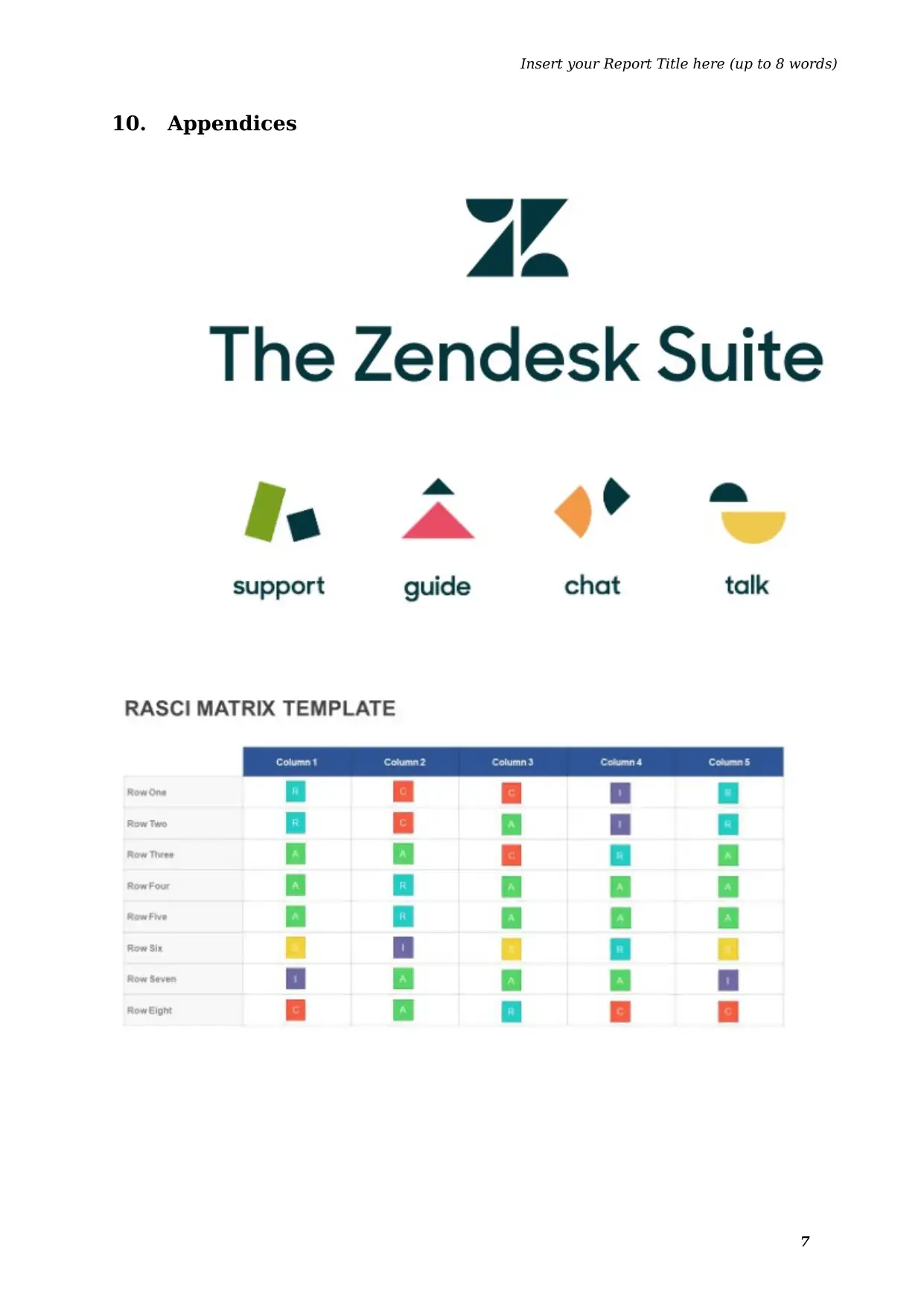
Insert your Report Title here (up to 8 words)
10. Appendices
7
10. Appendices
7
1 out of 7
Related Documents
Your All-in-One AI-Powered Toolkit for Academic Success.
+13062052269
info@desklib.com
Available 24*7 on WhatsApp / Email
![[object Object]](/_next/static/media/star-bottom.7253800d.svg)
Unlock your academic potential
Copyright © 2020–2025 A2Z Services. All Rights Reserved. Developed and managed by ZUCOL.


